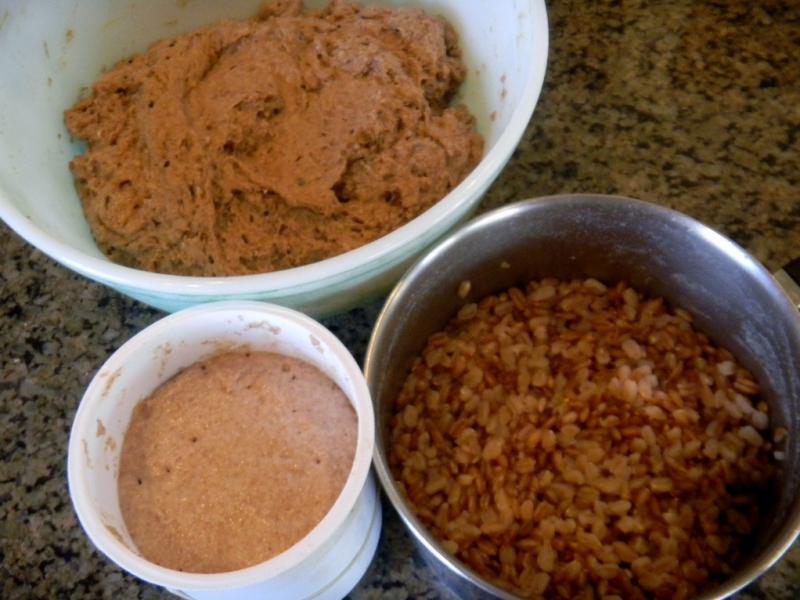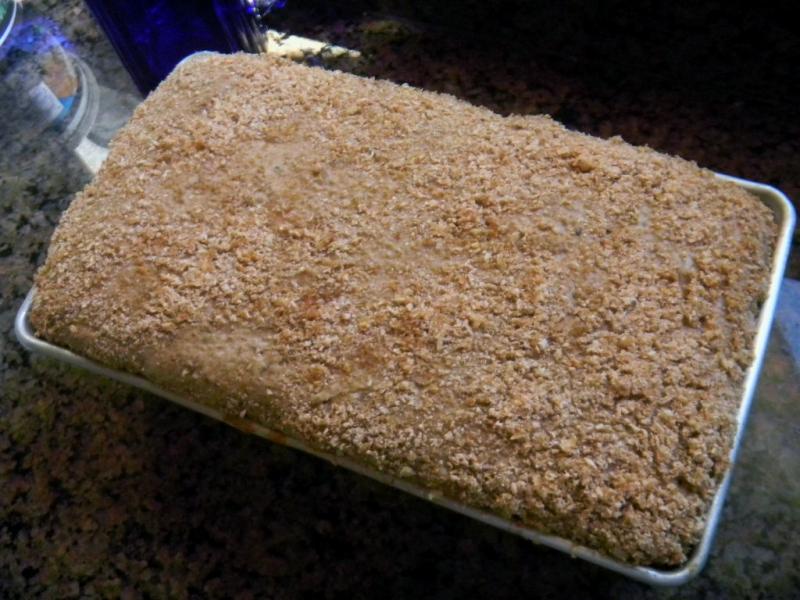
For the 2nd test of our new 2 week old WW starter, we though we would continue our 100% whole grain quest to a 3rd bake, similar to the last 2, but making a few changes along the way as my apprentice usually does. She just can’t leave well enough, or me either for that matter, alone.

We decided to add in some YW to the mix to help open the crumb of the planned pumpernickel baking temperature and schedule. We also decided to change from a 100% whole wheat, 100% whole grain bread to one that was still 100% whole grain but had equal portions of WW, Spelt and Rye. We omitted the VWG on this bake.


We also added some barley malt syrup and cut the molasses in half and throw in some bread spices consisting of; black and brown caraway, coriander, anise and fennel. To keep in line with the change in whole grains we also changed the whole berry scald to match it using WW, Spelt and Rye.


The resulting overall hydration of 87.5% is fairly in the middle of the pumpernickel hydrations we do around here in AZ where it is so dry all time. The method was pretty straight forward if a tiny bit unusual. We built the whole wheat combo SD YW levain together over (2) 4 hour builds where it easily doubled.


After a 1 hour autolyse that had everything in it but the levain and scald, we mixed the levain and the autolyse together with a spoon and then did 10 minutes of slap and folds trying to develop as much gluten as we could = what fun. We then folded in the scald berries with a bench knife.

Once the berries were evenly distributed, we tossed the paste into a large bread pan filling it about 3/4th full. The paste filled the pan fuller than we would normally like for pumpernickel but, my apprentice was lazy and refused to pull it out, divide it and put into two smaller cocktail pans.

She did, to be fair, reminded me that the Altus loaf at 300 G lsss in size actually shrank the last time leaving the finished bread 1” below the rim of this same pan. We dusted the loaf with oat bran and let it ferment on the counter for an hour before it went into the fridge covered in plastic, for a 16 hour retard.

It's a little more dense and moist on the bottom.
It had risen to the top of the pan when it came out of the fridge the next morning when it went into a plastic bag to warm up and do final proof on a heating pad for 3 hours. Since the bread would eventually rise almost an inch above the pan rim, we decided to bake it low and slow; pumpernickel style, in the WagnerWare, MagnaLite turkey roaster with the trivet inside so extra water could be added to steam the loaf.

The temperature reducing (as time goes on) baking schedule follows:
400 F - 30 minutes
375 F - 30 minutes
350 F - 30 minutes
325 F - 30 minutes
300 F - 1 hour
275 F - 2 hours
250 F - 2 hours
225 F - 1 ½ hours
200 F - 1 ½ hours

We had a powerful sunset last night
When the bread tests 205 F in the center, turn off the oven and leave the bread in the DO inside the oven for 8 -12 hours. We did 8 hours and the oven was still warm in the morning due to the two baking stones on the top and bottom rack of the oven.

The 3 P sandwich - DaPumpernickel, Pepperjack and Pate
Yes, it is a long bake but worth it in the end if you want to make a classic pumpernickel style loaf. Not that this one is a classic, since it isn't 100% rye, have cornmeal, potatoes or bacon fat in it. But this sure tastes like a pumpernickel even if it doesn't really use classic pumpernickel flours and uses an Irish Stout for much of the liquid. That’s the great thing about bread – there aren't any real rules, especially if you choose not to follow them like my apprentice. This bread smell tremendous with the caramelized grains, scald and aromatic seeds.

Love the first one so much we made a variant - DaPumpernickel, Irish Swiss and Pate open face
Sadly, even after it cools you don’t want to slice it for at least 32 hours. Just wrap it on linen or cotton and be as patient as you need to be…. We love pumpernickel and do not mind waiting, as long as, we win the Power Ball tonight for over $320 plus million. Well we didn't win the big moola drawing but we still won a jackpot none the less. We took a few slices off the loaf this morning for pictures and breakfast, re-wrapping the rest to let it sit another 24 hours before slicing it.

A close up open face sandwich - in your face:-)
This bread easily sliced 1/4" thick slices even for such a large loaf. The bread was open and very moist. It is also about the best tasting example of a non-traditional pumpernickel my German apprentice has ever tasted. She wanted to take the rest of the loaf outside to bury it in the back yard but I managed to stop her before she got to the doggie door. It is a powerful bread flavor wise, as much so as last night's sunset, and we can't wait to try it with some robust red wine, pate, cheese and fruit spread especially after this morning's toasted pumpernickel with butter, egg, hot sausage and bacon delight. Yummy.
Formula
SD Starter | Build 1 | Build 2 | Total | % |
Mini's WW Starter | 20 | 0 | 20 | 3.28% |
Yeast Water | 30 | 0 | 30 | 6.00% |
Whole Wheat | 50 | 50 | 100 | 20.00% |
Water | 20 | 40 | 60 | 12.00% |
Total | 90 | 90 | 210 | 42.00% |
| | | | |
SD Levain Totals | | % | | |
Flour | 110 | 22.00% | | |
Water | 100 | 20.00% | | |
Hydration | 90.91% | | | |
| | | | |
Levain % of Total | 16.15% | | | |
| | | | |
Dough Flour | | % | | |
Whole Rye | 165 | 33.00% | | |
Whole Spelt | 165 | 33.00% | | |
Whole Wheat | 170 | 34.00% | | |
Dough Flour | 500 | 100.00% | | |
| | | | |
Salt | 9 | 1.80% | | |
Guinness | 423 | 84.60% | | |
Dough Hydration | 84.60% | | | |
| | | | |
Total Flour | 610 | | | |
Guinness, YW & SD Starter Water | 523 | | | |
T. Dough Hydration | 85.74% | | | |
Whole Grain % | 100.00% | | | |
| | | | |
Hydration w/ Adds | 87.50% | | | |
Total Weight | 1,300 | | | |
| | | | |
Add - Ins | | % | | |
Red Rye Malt | 3 | 0.60% | | |
White Rye Malt | 3 | 0.60% | | |
Caraway, Anise, Fennel & Coriander | 16 | 3.20% | | |
Toadies | 4 | 0.80% | | |
Barley malt | 16 | 3.20% | | |
Molasses | 16 | 3.20% | | |
Total | 58 | 11.60% | | |